Cellulose Nanofibrils Dewatered with Poly(Lactic Acid) for Improved Bio-Polymer Nanocomposite Processing
Abstract
1. Introduction
2. Materials and Methods
2.1. Manufacturing and Characterization of Mixtures
2.2. Processing and Testing of Composites
2.3. Calculations for CNF Monolayer Formation
2.4. Analysis of Pressed Films with Polarized Light Microscopy
2.5. Particle Size Analysis with ImageJ
3. Results and Discussion
3.1. PLA-CNF Mixture Characterization
3.2. Testing of Composites
3.3. Modeling for CNF Monolayer Formation
3.4. Pressed Films with Polarized Light Microscopy Analysis Results
3.5. Particle Size Analysis Using ImageJ
3.6. Contact Dewatering Water Removal and Energy Analysis
4. Conclusions
- -
- Dewatered CNF at loading levels of 0.1–2 wt.% in PLA powder preserved nano-to-microscale CNF dimensions in pressed PLA films;
- -
- In compression molded films, CNFs significantly increased the tensile properties of PLA in the range of 0.1–1 wt.% loading, but agglomeration at 2 wt.% and above reduced tensile strength compared to pure PLA;
- -
- In shear-mixed composites, PLA with dewatered CNFs showed comparable tensile strength and better tensile modulus than pure PLA or PLA with SDCNF at 1–2 wt.% dewatered CNF loading levels;
- -
- Modeling the agglomeration threshold based on spherical particles did not agree with results obtained from PLM image analysis, so the model assumptions should be updated to more accurately reflect the fibril agglomeration;
- -
- Shear-mixing PLA-2 wt.% dCNF broke up agglomerates seen in compression molded films and produced test samples with the highest tensile properties;
- -
- In subsequent work, higher loading levels of PLA-dCNF could be shear-mixed and tested to determine the maximum level of CNFs that can be dewatered onto PLA without reducing mechanical properties;
- -
- Dewatering is a much more energy-efficient method of producing dried, micron-to-nanoscale CNFs for composites than spray-drying.
Supplementary Materials
Author Contributions
Funding
Data Availability Statement
Conflicts of Interest
Abbreviations
References
- Derraik, J.G.B. The pollution of the marine environment by Plastic Debris: A Review. Mar. Pollut. Bull. 2002, 44, 842–852. [Google Scholar] [CrossRef] [PubMed]
- Cole, M.; Lindeque, P.; Halsband, C.; Galloway, T.S. Microplastics as contaminants in the marine environment: A Review. Mar. Pollut. Bull. 2011, 62, 2588–2597. [Google Scholar] [CrossRef] [PubMed]
- Sorrell, S.; Speirs, J.; Bentley, R.; Brandt, A.; Miller, R. Global oil depletion: A review of the evidence. Energy Policy 2010, 38, 5290–5295. [Google Scholar] [CrossRef]
- Zhai, L.; Kim, H.C.; Kim, J.W.; Kang, J.; Kim, J. Elastic moduli of cellulose nanofibers isolated from various cellulose resources by using aqueous counter collision. Cellulose 2018, 25, 4261–4268. [Google Scholar] [CrossRef]
- Moon, R.J.; Martini, A.; Nairn, J.; Simonsen, J.; Youngblood, J. Cellulose nanomaterials review: Structure, properties and nanocomposites. Chem. Soc. Rev. 2011, 40, 3941–3994. [Google Scholar] [CrossRef]
- Pérez, J.; Muñoz-Dorado, J.; De La Rubia, T.; Martínez, J. Biodegradation and biological treatments of cellulose, hemicellulose and lignin: An overview. Int. Microbiol. 2002, 5, 53–63. [Google Scholar] [CrossRef]
- Moon, D.; Sagisaka, M.; Tahara, K.; Tsukahara, K. Progress towards sustainable production: Environmental, economic, and social assessments of the cellulose nanofiber production process. Sustainability 2017, 9, 2368. [Google Scholar] [CrossRef]
- Listo, A. Past, Present and Future of Maine’s Pulp and Paper Industry. Electronic Theses and Dissertations, The University of Maine, Orono, ME, USA, 2018. Available online: https://digitalcommons.library.umaine.edu/etd/2903 (accessed on 29 August 2024).
- Peng, Y.; Gardner, D.J.; Han, Y. Drying cellulose nanofibrils: In search of a suitable method. Cellulose 2011, 19, 91–102. [Google Scholar] [CrossRef]
- Fu, S.Y.; Feng, X.Q.; Lauke, B.; Mai, Y.W. Effects of particle size, particle/matrix interface adhesion and particle loading on mechanical properties of particulate–polymer composites. Composites Part B Eng. 2008, 39, 933–961. [Google Scholar] [CrossRef]
- Baker, C.G.J.; McKenzie, K.A. Energy consumption of industrial spray dryers. Dry. Technol. 2005, 23, 365–386. [Google Scholar] [CrossRef]
- Murayama, K.; Yamamoto, M.; Kobori, H.; Kojima, Y.; Suzuki, S.; Aoki, K.; Ito, H.; Ogoe, S.; Okamoto, M. Mechanical and physical properties of wood-plastic composites containing cellulose nanofibers added to wood flour. For. Prod. J. 2018, 68, 398–404. [Google Scholar] [CrossRef]
- Li, J.; Li, D.; Song, Z.; Shang, S.; Guo, Y. Preparation and properties of wood plastic composite reinforced by ultralong cellulose nanofibers. Polym. Compos. 2014, 37, 1206–1215. [Google Scholar] [CrossRef]
- Tajvidi, M.; Gardner, D.J.; Bousfield, D.W. Cellulose nanomaterials as Binders: Laminate and particulate systems. J. Renew. Mater. 2016, 4, 365–376. [Google Scholar] [CrossRef]
- Amini, E.; Tajvidi, M.; Bousfield, D.W.; Gardner, D.J.; Shaler, S.M. Dewatering behavior of a wood-cellulose Nanofibril particulate system. Sci. Rep. 2019, 9, 14584. [Google Scholar] [CrossRef] [PubMed]
- Collins, A.; Tajvidi, M. Contact-dewatered cellulose nanomaterials for reinforced biopolymer composites. Mater. Today Commun. 2022, 31, 103443. [Google Scholar] [CrossRef]
- Jonoobi, M.; Harun, J.; Mathew, A.P.; Oksman, K. Mechanical properties of cellulose nanofiber (CNF) reinforced polylactic acid (PLA) prepared by twin screw extrusion. Compos. Sci. Technol. 2010, 70, 1742–1747. [Google Scholar] [CrossRef]
- Trifol, J.; Plackett, D.; Szabo, P.; Daugaard, A.E.; Baschetti, M.G. Effect of crystallinity on water vapor sorption, diffusion, and permeation of PLA-based nanocomposites. ACS Omega 2020, 5, 15362–15369. [Google Scholar] [CrossRef] [PubMed]
- Copenhaver, K.; Bista, B.; Wang, L.; Bhagia, S.; Lamm, M.; Zhao, X.; Tajvidi, M.; Gramlich, W.M.; Hubbard, A.M.; Clarkson, C.; et al. Improving the Recyclability of Polymer Composites With Cellulose Nanofibrils. J. Polym. Environ. 2024, 1–15. [Google Scholar] [CrossRef]
- Re, G.L.; Engström, J.; Wu, Q.; Malmström, E.; Gedde, U.W.; Olsson, R.T.; Berglund, L. Improved cellulose nanofibril dispersion in melt-processed polycaprolactone nanocomposites by a latex-mediated inter-phase and wet feeding as LDPE alternative. ACS Appl. Nano Mater. 2018, 1, 2669–2677. [Google Scholar] [CrossRef]
- Gabriel, V.A.; Tousignant, M.N.; Wilson, S.M.; Faure, M.D.; Cranston, E.D.; Cunningham, M.F.; Lessard, B.H.; Dubé, M.A. Improving Latex-Based Pressure-Sensitive Adhesive Properties Using Carboxylated Cellulose Nanocrystals. Macromol. React. Eng. 2021, 16, 2100051. [Google Scholar] [CrossRef]
- ASTM D790-17; Standard Test Methods for Flexural Properties of Unreinforced and Reinforced Plastics and Electrical Insulating Materials. ASTM International: West Conshohocken, PA, USA, 2017.
- ASTM D7205/D7205M-06; Standard Test Method for Tensile Properties of Fiber Reinforced Polymer Matrix Composite Bars. ASTM International: West Conshohocken, PA, USA, 2016.
- ASTM D256-10; Standard Test Methods for Determining the Izod Pendulum Impact Resistance of Plastics. ASTM International: West Conshohocken, PA, USA, 2018.
- ASTM D882-18; Standard Test Method for Tensile Properties of Thin Plastic Sheeting. ASTM International: West Conshohocken, PA, USA, 2018.
- ASTM D6287-17; Standard Practice for Cutting Film and Sheeting Test Specimens. ASTM International: West Conshohocken, PA, USA, 2018.
- Ghasemi, S.; Rahimzadeh-Bajgiran, P.; Tajvidi, M.; Shaler, S.M. Birefringence-based orientation mapping of cellulose nanofibrils in thin films. Cellulose 2020, 27, 677–692. [Google Scholar] [CrossRef]
- Schneider, C.A.; Rasband, W.S.; Eliceiri, K.W. NIH image to imagej: 25 years of image analysis. Nat. Methods 2012, 9, 671–675. [Google Scholar] [CrossRef] [PubMed]
- Broadbent, S.R.; Hammersley, J.M. Percolation processes: I. Crystals and mazes. In Mathematical Proceedings of the Cambridge Philosophical Society; Cambridge University Press: Cambridge, UK, 1957; Volume 53, pp. 629–641. [Google Scholar]
- Park, S.; Venditti, R.A.; Jameel, H.; Pawlak, J.J. Hard to remove water in cellulose fibers characterized by high resolution thermogravimetric analysis—Methods development. Cellulose 2005, 13, 23–30. [Google Scholar] [CrossRef]
- Hatakeyama, T.; Nakamura, K.; Hatakeyama, H. Vaporization of bound water associated with cellulose fibres. Thermochim. Acta 2000, 352–353, 233–239. [Google Scholar] [CrossRef]
- Salaberria, A.M.; Diaz, R.H.; Andrés, M.A.; Fernandes, S.C.; Labidi, J. The antifungal activity of functionalized chitin nanocrystals in poly (Lactid Acid) films. Materials 2017, 10, 546. [Google Scholar] [CrossRef]
- Kim, J.-K.; Oh, S.H.; Song, M.-O.; Jang, S.; Kang, S.J.; Kwak, S.K.; Jin, J.; Kim, J.-K.; Oh, S.H.; Song, M.-O.; et al. Wholly bio-based, ultra-tough, transparent PLA composites reinforced with nanocellulose and nanochitin. Compos. Part B Eng. 2024, 281, 111563. [Google Scholar] [CrossRef]
- Kelly, P.V.; Es-Haghi, S.S.; Lamm, M.E.; Copenhaver, K.; Ozcan, S.; Gardner, D.J.; Gramlich, W.M. Polymer-grafted cellulose nanofibrils with enhanced interfacial compatibility for stronger poly (lactic acid) composites. ACS Appl. Polym. Mater. 2023, 5, 3661–3676. [Google Scholar] [CrossRef]
- Ghasemi, S.; Behrooz, R.; Rahimi, M. Using spray dried nanofibrillated Cellulose as an alternative to upgrading its effect in PLA nanocomposite. Int. J. Nano Dimens. 2023, 14, 167–177. [Google Scholar] [CrossRef]
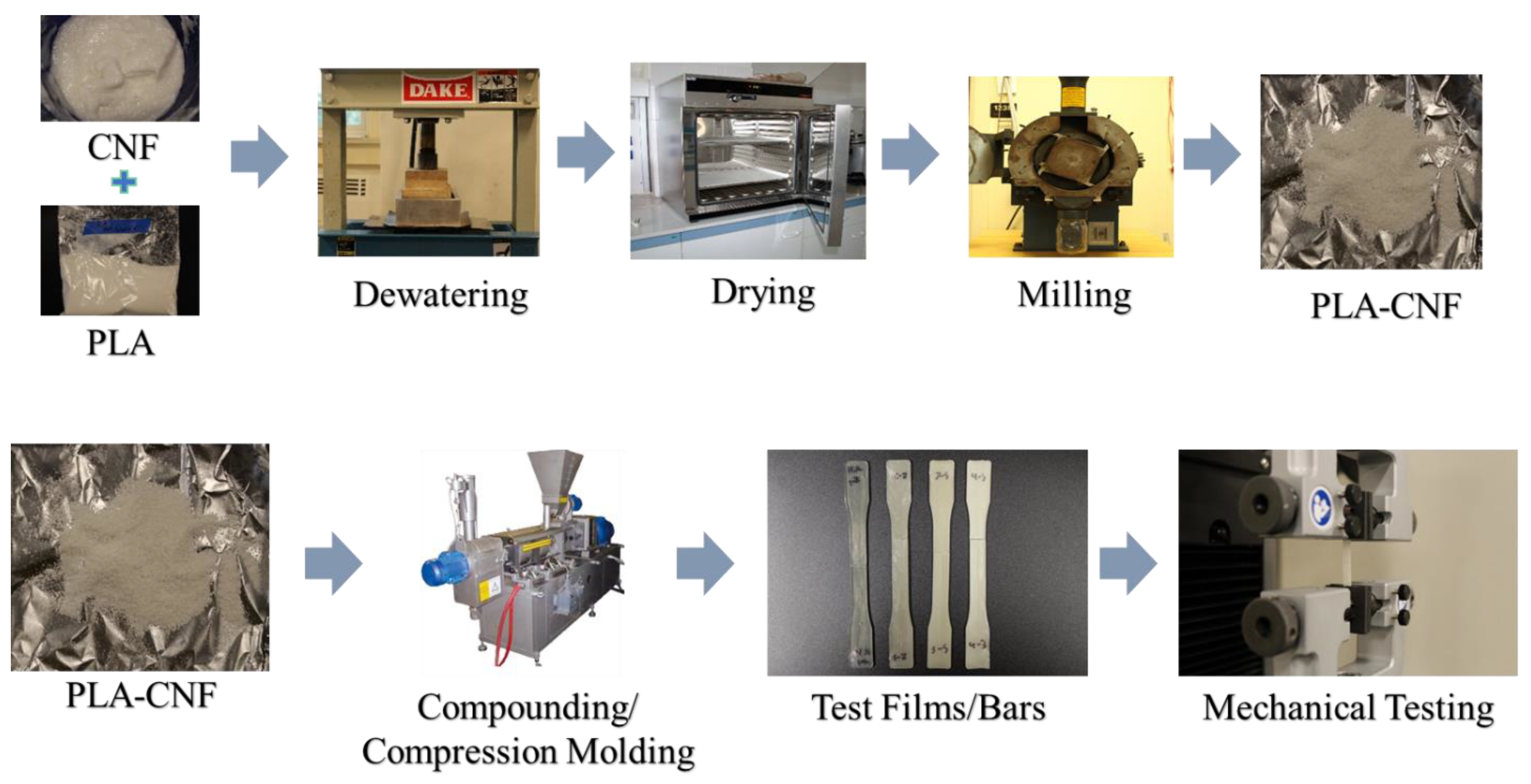
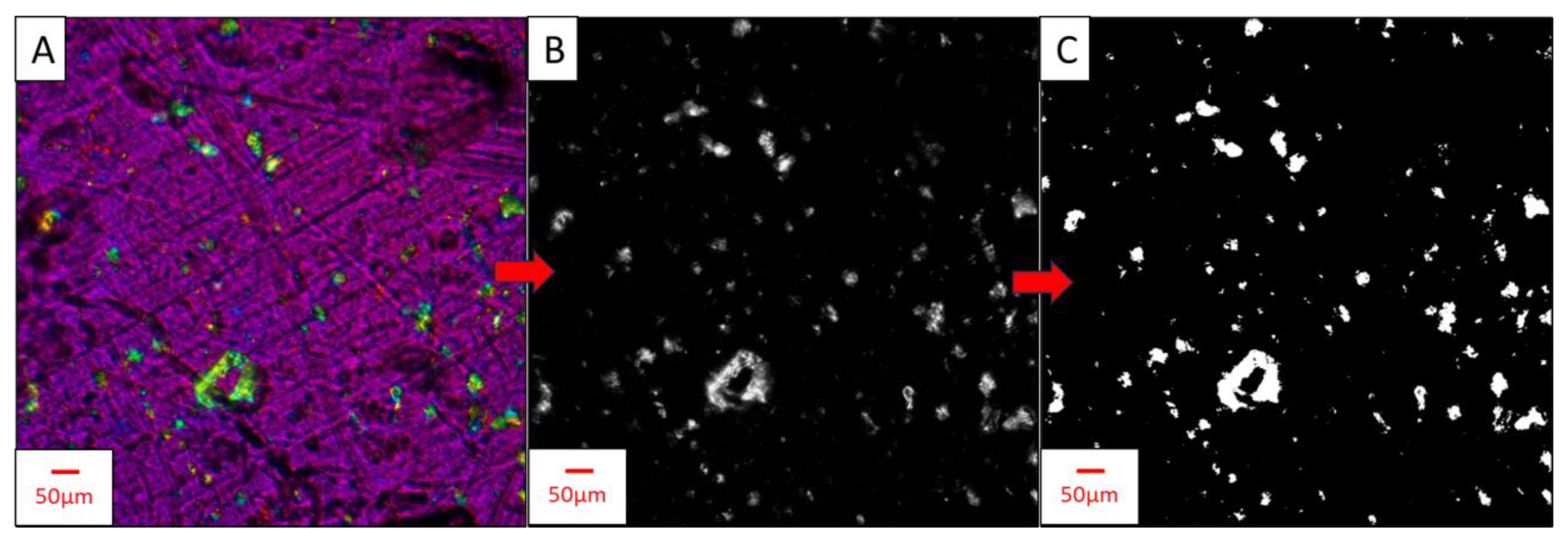
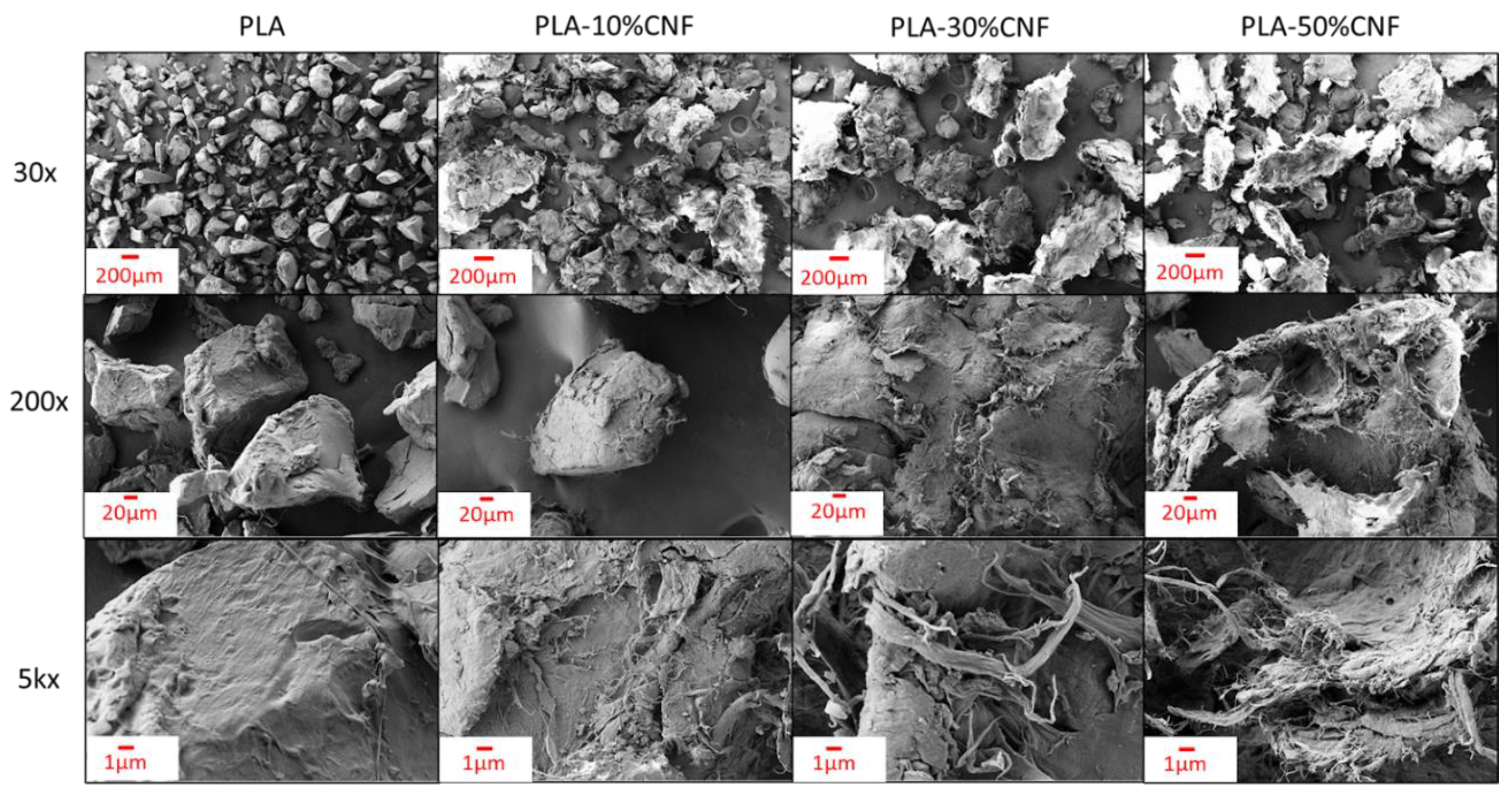
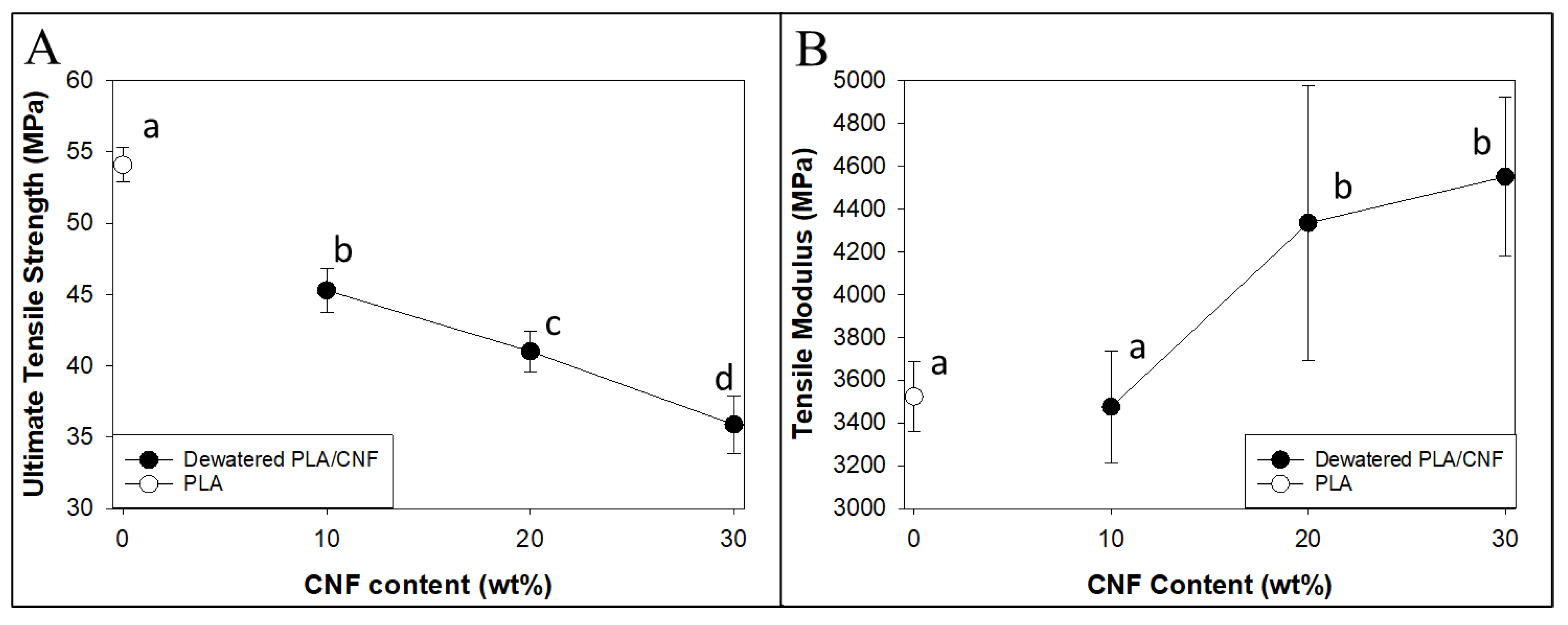
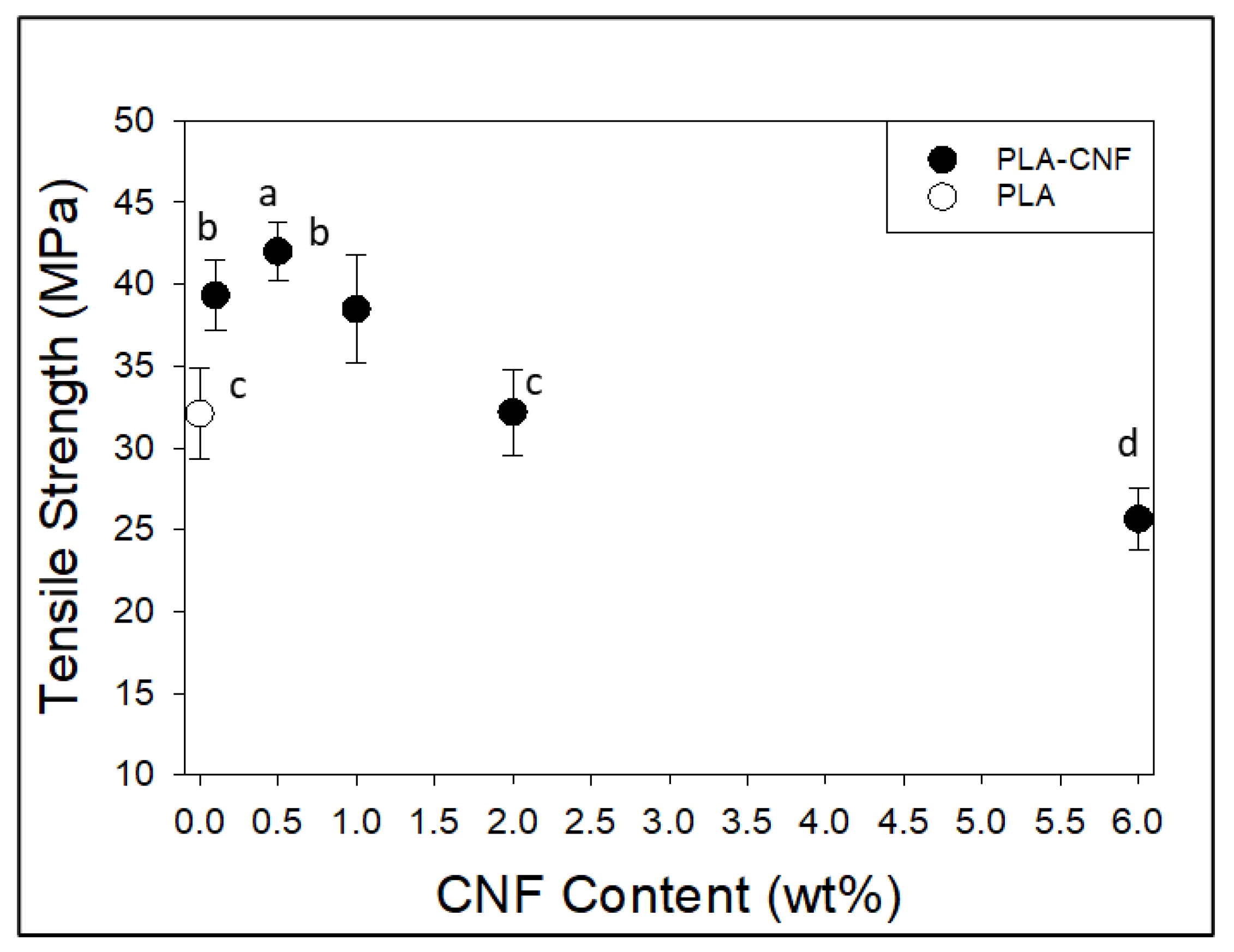

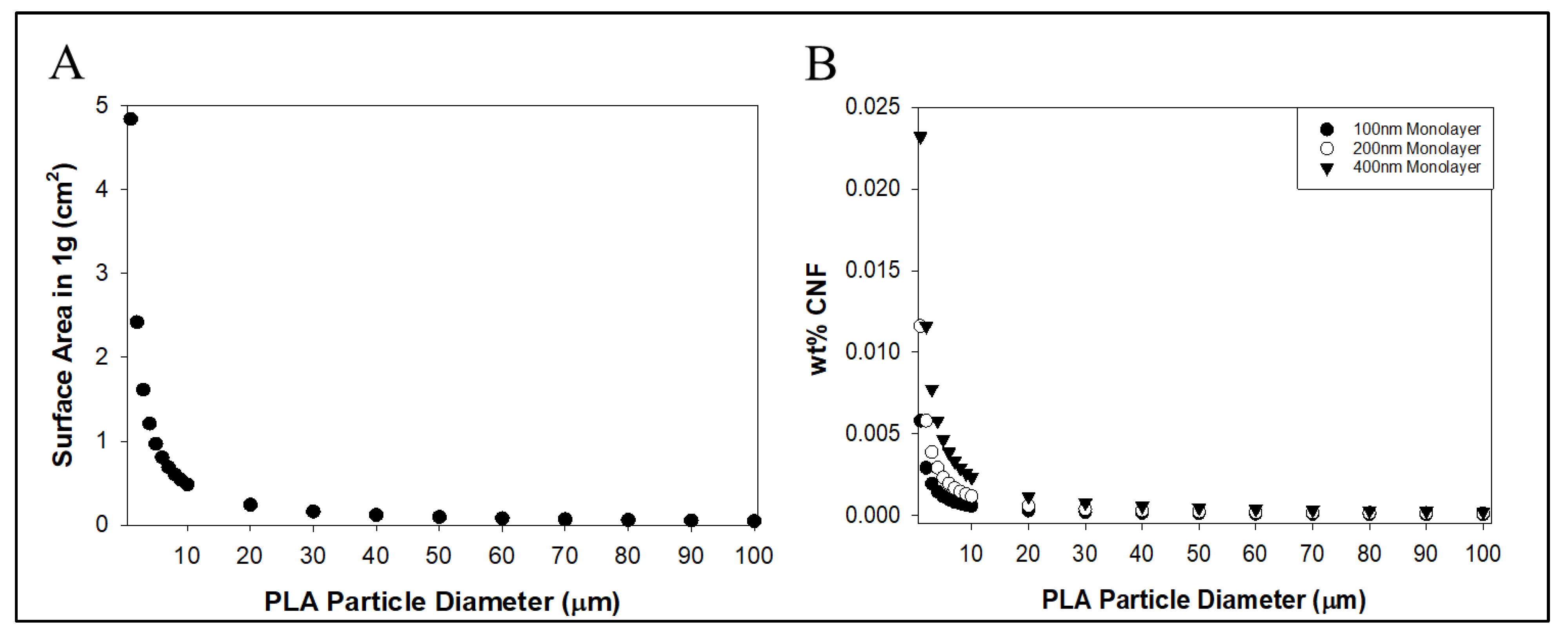



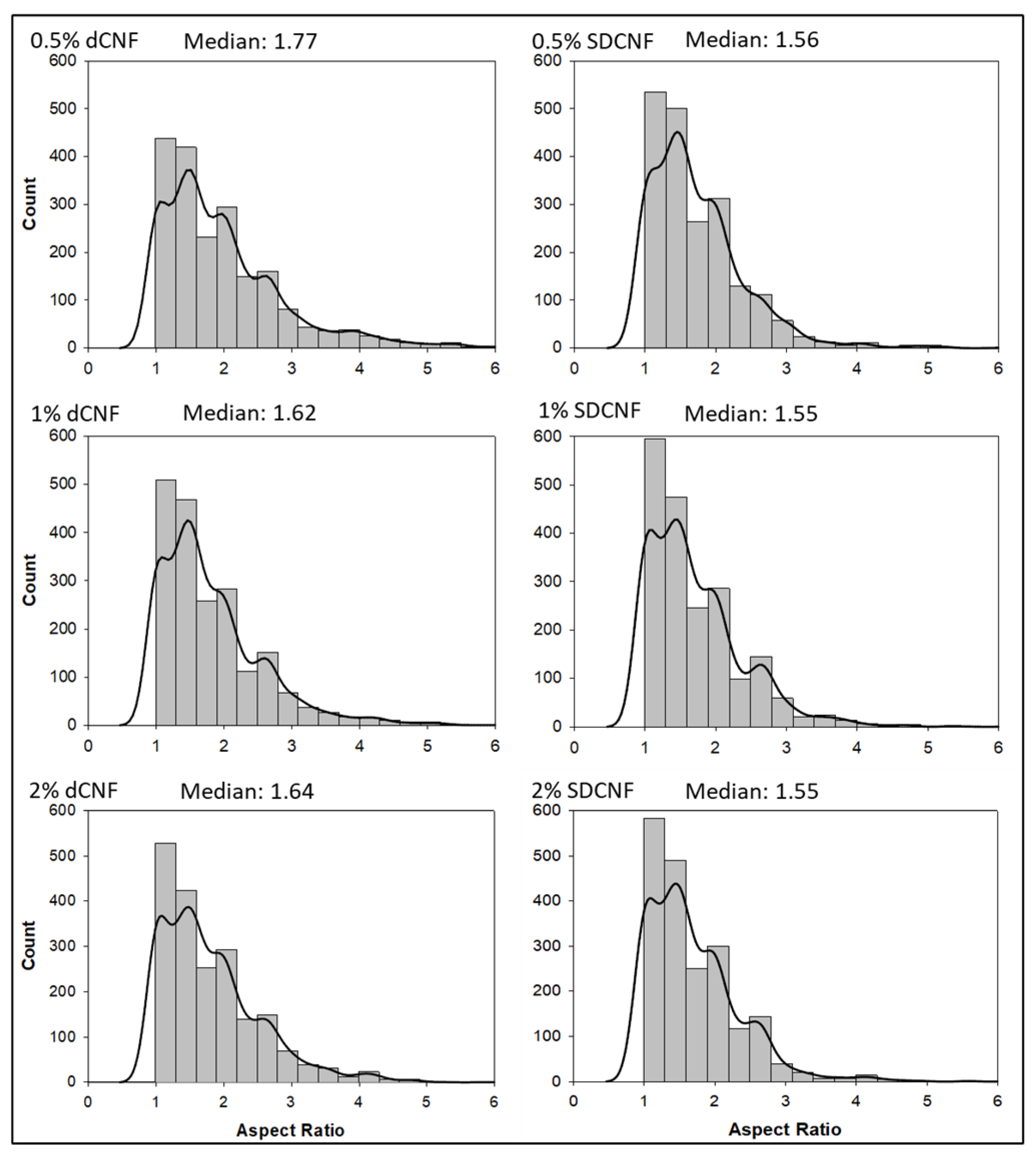
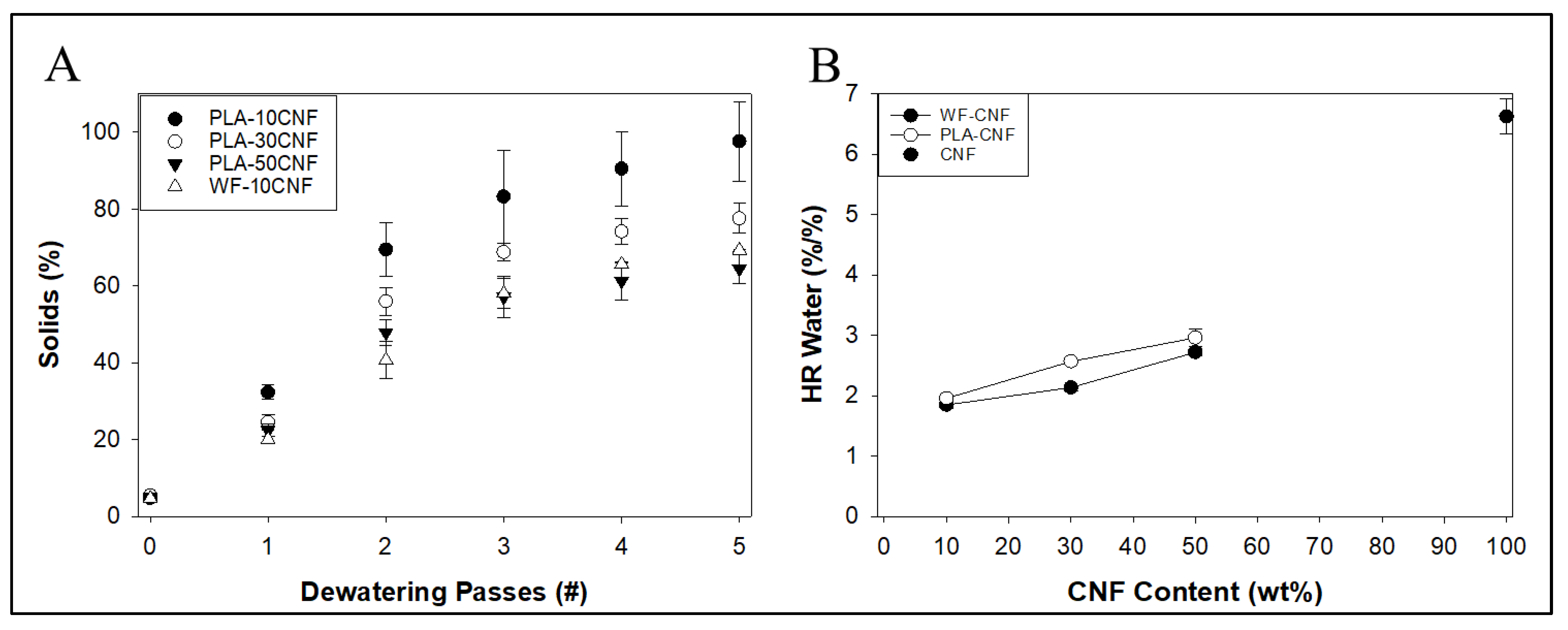
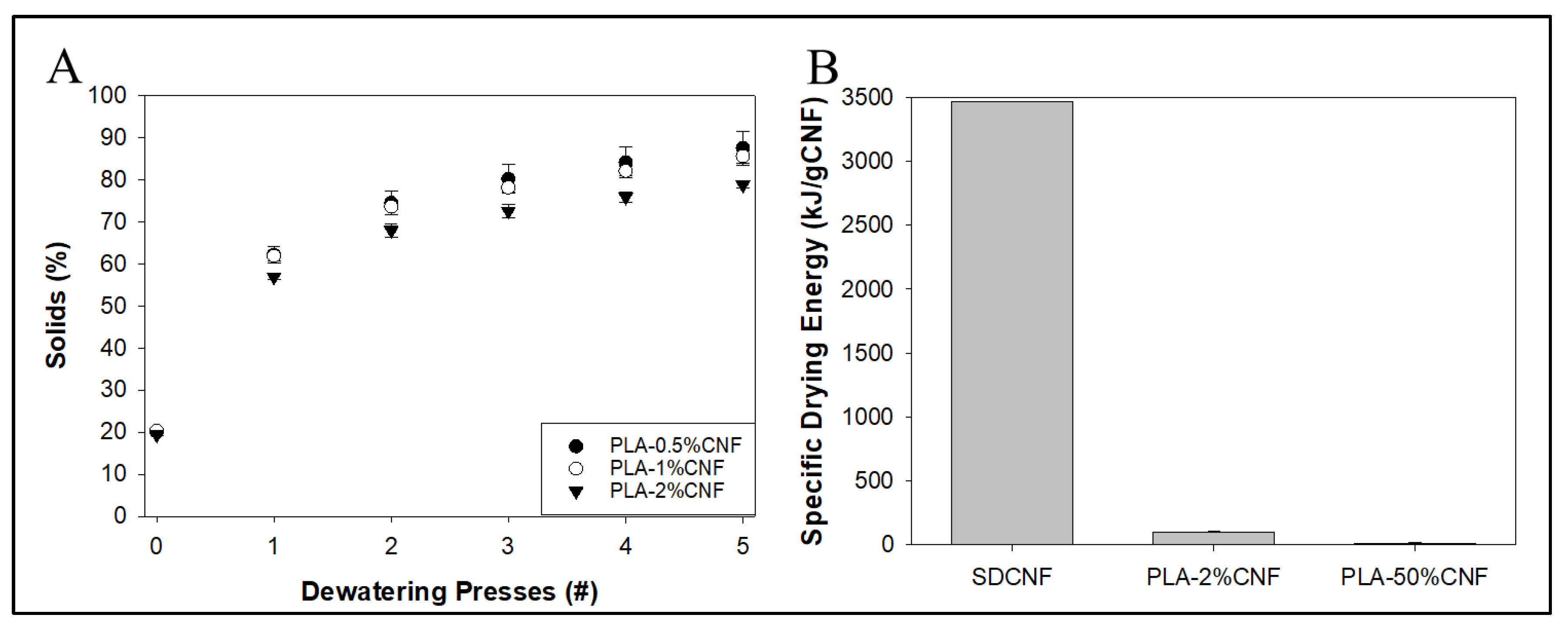
| Mixture | Fraction Diameter (μm) | Mass % |
|---|---|---|
| PLA | >250 | 4.5 |
| 150–250 | 39.2 | |
| <150 | 56.3 | |
| PLA-10% CNF | >250 | 42.7 |
| 150–250 | 36.8 | |
| <150 | 20.5 | |
| PLA-50% CNF | >250 | 85.7 |
| 150–250 | 8.7 | |
| <150 | 5.6 |
Disclaimer/Publisher’s Note: The statements, opinions and data contained in all publications are solely those of the individual author(s) and contributor(s) and not of MDPI and/or the editor(s). MDPI and/or the editor(s) disclaim responsibility for any injury to people or property resulting from any ideas, methods, instructions or products referred to in the content. |
© 2024 by the authors. Licensee MDPI, Basel, Switzerland. This article is an open access article distributed under the terms and conditions of the Creative Commons Attribution (CC BY) license (https://creativecommons.org/licenses/by/4.0/).
Share and Cite
Collins, A.; Tajvidi, M. Cellulose Nanofibrils Dewatered with Poly(Lactic Acid) for Improved Bio-Polymer Nanocomposite Processing. Nanomaterials 2024, 14, 1419. https://doi.org/10.3390/nano14171419
Collins A, Tajvidi M. Cellulose Nanofibrils Dewatered with Poly(Lactic Acid) for Improved Bio-Polymer Nanocomposite Processing. Nanomaterials. 2024; 14(17):1419. https://doi.org/10.3390/nano14171419
Chicago/Turabian StyleCollins, Alexander, and Mehdi Tajvidi. 2024. "Cellulose Nanofibrils Dewatered with Poly(Lactic Acid) for Improved Bio-Polymer Nanocomposite Processing" Nanomaterials 14, no. 17: 1419. https://doi.org/10.3390/nano14171419
APA StyleCollins, A., & Tajvidi, M. (2024). Cellulose Nanofibrils Dewatered with Poly(Lactic Acid) for Improved Bio-Polymer Nanocomposite Processing. Nanomaterials, 14(17), 1419. https://doi.org/10.3390/nano14171419






